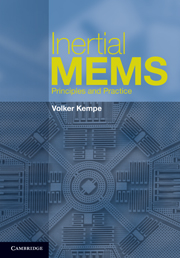3 - Non-inertial forces
Published online by Cambridge University Press: 03 May 2011
Summary
Force compensation is the basic principle of inertial MEMS. For instance, accelerations acting on a movable mass create deflections that are limited by counter forces. Without restoring forces the inertial mass would bump into the walls of the sparingly calculated measurement cavity. Hence, the exploitation of restoring forces is the key principle of all inertial sensors. For stationary accelerations or rate signals they allow the system to reach a spatially stationary equilibrium state of moving masses within the measuring room.
Restoring forces typically are generated by elastic deformations. If the movable mass is suspended by cantilever beams, tethers, hinges or other elastic members with negligible masses, and if the deformation of the inertial object itself can be neglected, then the system can be described by a lumped-element approximation consisting of stiff members and elastic springs or hinges, which are described in terms of their spring rates. In most cases this approximation holds for the operating range of applied inertial forces. For overloads like shocks and large vibrations the deformation of all elements of the mechanical system – including the inertial masses – should be taken into account. Furthermore, for some systems, such as an elastic beam under acceleration, the mass of the beam itself creates inertial forces, so a lumped-element approximation is impossible. Some such systems will be considered later (see, for example, Section 7.4).
- Type
- Chapter
- Information
- Inertial MEMSPrinciples and Practice, pp. 79 - 151Publisher: Cambridge University PressPrint publication year: 2011
- 2
- Cited by



